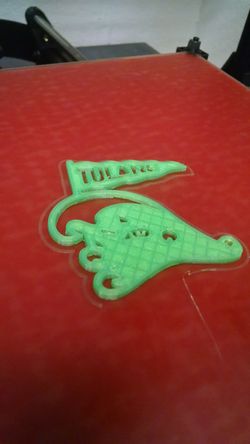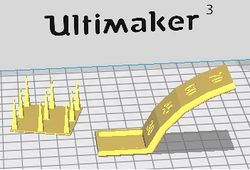3D Printing: Difference between revisions
No edit summary |
m (Moved "looking for how to print?" to the beginning of the page) |
||
| (23 intermediate revisions by 5 users not shown) | |||
| Line 1: | Line 1: | ||
[[File:3dprintexample.JPG|250px|thumb|right|Example of a 3D print on the [[LulzBot TAZ 5]], immediately after completion]] | [[File:3dprintexample.JPG|250px|thumb|right|Example of a 3D print on the [[LulzBot TAZ 5]], immediately after completion]] | ||
<big><big>Looking For How To Print? Check out [[Printing with Orca Slicer]]</big></big> | |||
3D printing is a modern rapid prototyping technique in which a solid object is created through a layered deposition process. 3D printing is referred to as an "additive manufacturing" technique, as instead of taking material away from a stock piece in order to create a desired object, such as in milling or turning manufacturing techniques, the material for the object is added by the printing process. 3D printing techniques make it very simple to quickly create both complex and simple objects. | 3D printing is a modern rapid prototyping technique in which a solid object is created through a layered deposition process. 3D printing is referred to as an "additive manufacturing" technique, as instead of taking material away from a stock piece in order to create a desired object, such as in milling or turning manufacturing techniques, the material for the object is added by the printing process. 3D printing techniques make it very simple to quickly create both complex and simple objects. | ||
The 3D printers available in the MakerSpace are all Fused Filament Fabrication (FFF) printers, meaning that to create the desired part, molten polymer (melted plastic) is "extruded" into a thin molten filament, which is deposited in the desired shape. The hot plastic fuses with previously deposited layers, creating the desired part. Due to the nature of molten plastic, FFF | The 3D printers available in the MakerSpace are all Fused Filament Fabrication (FFF) printers, meaning that to create the desired part, molten polymer (melted plastic) is "extruded" into a thin molten filament, which is deposited in the desired shape. The hot plastic fuses with previously deposited layers, creating the desired part. Due to the nature of molten plastic, FFF 3D printed parts have a degree of "slop" that is difficult to eliminate, so a different manufacturing technique, such as [[laser cutting]] or [[CNC Routing/Milling]], is likely necessary for parts that require very high degrees of accuracy. | ||
The Tulane MakerSpace contains [https:// | The Tulane MakerSpace contains [https://www.creality.com/pages/products?collection=Ender+Series&spm=..index.header_1.1&spm_prev=..product_ce00868d-efe2-4fa8-9168-240e7c3b3cd1.header_1.1 Creality Ender] and [https://bambulab.com/en BambuLab P1 and X1 Series] 3D printers with heated beds to allow for any extruded 1.75mm filament. ABS filament allows for better [[finishing effects]] (such as [[Finishing_effects#Smoothing|smoothing]]), but PLA provides a more rigid part and has has much better adherence to the print bed. There are other advantages and disadvantages to both. Cost is the same (currently ~$18 per kg). The Makerspace currently supplies free PLA for use, other filaments and specific colors should be user supplied. | ||
While ABS and PLA are the most commonly used filaments, many other products exist with special qualities (flexible) or appearance (wood, ceramic). There is a good summary and comparison at [https://www.matterhackers.com/3d-printer-filament-compare MatterHackers]. MakerSpace users wishing to try out these filaments should procure them and work with a | While ABS and PLA are the most commonly used filaments, many other products exist with special qualities (flexible) or appearance (wood, ceramic). There is a good summary and comparison at [https://www.matterhackers.com/3d-printer-filament-compare MatterHackers]. MakerSpace users wishing to try out these filaments should procure them and work with a Fab Tech to load them onto the printer. | ||
The standard [[slicing software]] favored for these printers is [[ | The standard [[slicing software]] favored for these printers is [[Printing with Orca Slicer|Orca Slicer]], which allows you to arrange and size your model and set options for the printer to follow. All makerspace FDM printers can be printed to via Orca Slicer. | ||
== Available 3D Printers == | == Available 3D Printers == | ||
For information on safety and [[PPE]] requirements for each machine in the MakerSpace, see the [[Job Hazard Analysis]] forms. | For information on safety and [[PPE]] requirements for each machine in the MakerSpace, see the [[Safety and Manuals|Job Hazard Analysis]] forms. | ||
[[Bambu P1 Series]] | |||
[[Creality Ender 3]] | |||
[[Creality Ender 5]] | |||
[[ | [[Bambu X1 Series]] (advanced) | ||
<br/> | <br/> | ||
== | == Test Files == | ||
[[ | [https://www.matterhackers.com/articles/top-ten-prints-to-calibrate-your-3d-printer?utm_source=MatterHackers+Newsletter&utm_campaign=5c1691fac3-EMAIL_CAMPAIGN_2019_02_26_06_41_COPY_01&utm_medium=email&utm_term=0_dccd3cdce8-5c1691fac3-127501653 Matter Hackers] has a collection of test files that are useful after repairing or re-calibrating a printer. Here's another version of the description | ||
[[ | [[File:Matter_Hackers_3d_printer_tests.pdf]] | ||
[[ | These are a great way to compare two different print settings or brands of filament. | ||
[[File:Print_test.jpg|250px|thumb|right|Test prints for retraction and overhang]] | |||
[[File:1_MAKE_Robot_V6.stl]] | |||
[[File:2_XY-test.stl]] | |||
[[File:2_XY-test-1mmWall.stl]] | |||
[[File:3_TopSurfaceQuality.stl]] | |||
[[File:4_DimmensionalAccuracy.stl]] | |||
[[File:5_overhang_test.stl]] | |||
[[File:6_bridging_test.stl]] | |||
[[File:7_negative_space_tolerance_test.stl]] | |||
[[File:10_support-Deeper.stl]] | |||
[[File:11_Z_resonance_test.stl]] | |||
[[File:12_retraction_performance_test.stl]] | |||
[[File:13_Squareness.stl]] | |||
[[File:14_BigBed.stl]] | |||
== 3D Printing Problems == | |||
[http://support.3dverkstan.se/article/23-a-visual-ultimaker-troubleshooting-guide 3dVerkstan] has a fantastic guide to diagnosing print failures. It is specifically written for Ultimaker printers, but the information applies to any type of 3d printer. | |||
[https://www.simplify3d.com/ Simplify 3D] has created an extremely helpful [https://www.simplify3d.com/support/print-quality-troubleshooting/#lines-on-the-side-of-print Print Quality Troubleshooting Guide]. | [https://www.simplify3d.com/ Simplify 3D] has created an extremely helpful [https://www.simplify3d.com/support/print-quality-troubleshooting/#lines-on-the-side-of-print Print Quality Troubleshooting Guide]. | ||
[http://reprap.org/wiki/Main_Page RepRap] also has a helpful wiki which contains a [http://reprap.org/wiki/Print_Troubleshooting_Pictorial_Guide Print Troubleshooting Pictorial Guide]. | [http://reprap.org/wiki/Main_Page RepRap] also has a helpful wiki which contains a [http://reprap.org/wiki/Print_Troubleshooting_Pictorial_Guide Print Troubleshooting Pictorial Guide]. | ||
Also check out the | <!-- Also check out the Fab Tech reported 3D printing problem log [[Ninja Log]]. --> | ||
Latest revision as of 17:28, 7 February 2024

Looking For How To Print? Check out Printing with Orca Slicer
3D printing is a modern rapid prototyping technique in which a solid object is created through a layered deposition process. 3D printing is referred to as an "additive manufacturing" technique, as instead of taking material away from a stock piece in order to create a desired object, such as in milling or turning manufacturing techniques, the material for the object is added by the printing process. 3D printing techniques make it very simple to quickly create both complex and simple objects.
The 3D printers available in the MakerSpace are all Fused Filament Fabrication (FFF) printers, meaning that to create the desired part, molten polymer (melted plastic) is "extruded" into a thin molten filament, which is deposited in the desired shape. The hot plastic fuses with previously deposited layers, creating the desired part. Due to the nature of molten plastic, FFF 3D printed parts have a degree of "slop" that is difficult to eliminate, so a different manufacturing technique, such as laser cutting or CNC Routing/Milling, is likely necessary for parts that require very high degrees of accuracy.
The Tulane MakerSpace contains Creality Ender and BambuLab P1 and X1 Series 3D printers with heated beds to allow for any extruded 1.75mm filament. ABS filament allows for better finishing effects (such as smoothing), but PLA provides a more rigid part and has has much better adherence to the print bed. There are other advantages and disadvantages to both. Cost is the same (currently ~$18 per kg). The Makerspace currently supplies free PLA for use, other filaments and specific colors should be user supplied.
While ABS and PLA are the most commonly used filaments, many other products exist with special qualities (flexible) or appearance (wood, ceramic). There is a good summary and comparison at MatterHackers. MakerSpace users wishing to try out these filaments should procure them and work with a Fab Tech to load them onto the printer.
The standard slicing software favored for these printers is Orca Slicer, which allows you to arrange and size your model and set options for the printer to follow. All makerspace FDM printers can be printed to via Orca Slicer.
Available 3D Printers
For information on safety and PPE requirements for each machine in the MakerSpace, see the Job Hazard Analysis forms.
Bambu X1 Series (advanced)
Test Files
Matter Hackers has a collection of test files that are useful after repairing or re-calibrating a printer. Here's another version of the description
File:Matter Hackers 3d printer tests.pdf
These are a great way to compare two different print settings or brands of filament.

File:4 DimmensionalAccuracy.stl
File:7 negative space tolerance test.stl
File:12 retraction performance test.stl
3D Printing Problems
3dVerkstan has a fantastic guide to diagnosing print failures. It is specifically written for Ultimaker printers, but the information applies to any type of 3d printer.
Simplify 3D has created an extremely helpful Print Quality Troubleshooting Guide.
RepRap also has a helpful wiki which contains a Print Troubleshooting Pictorial Guide.